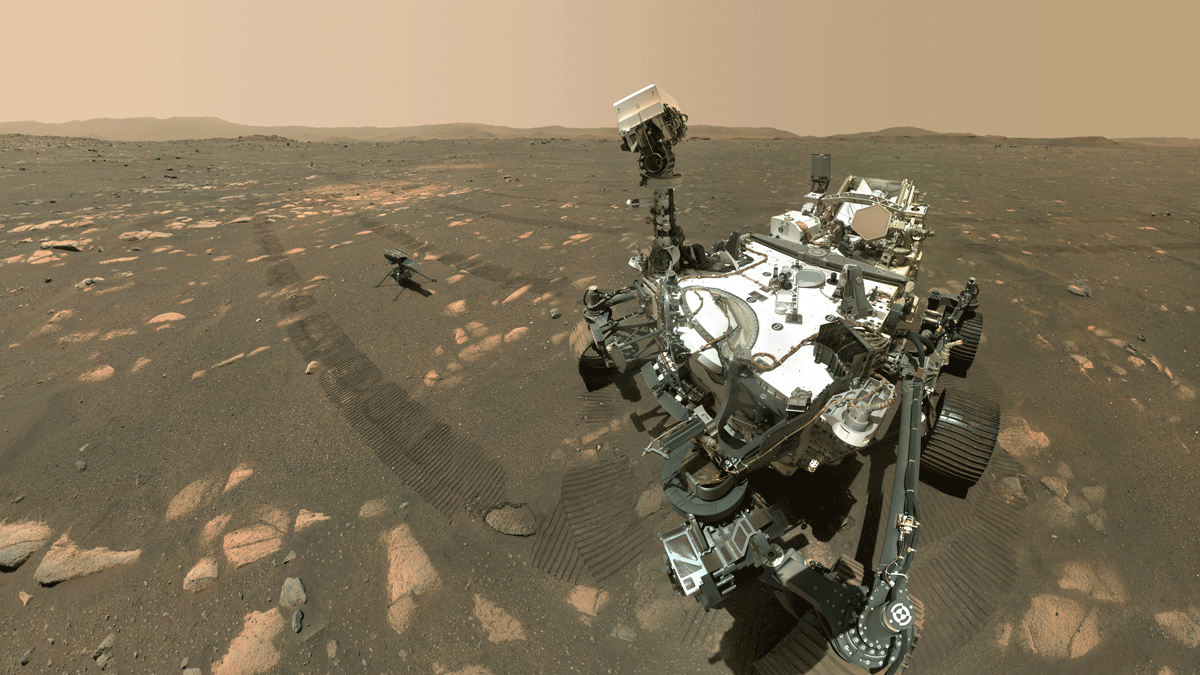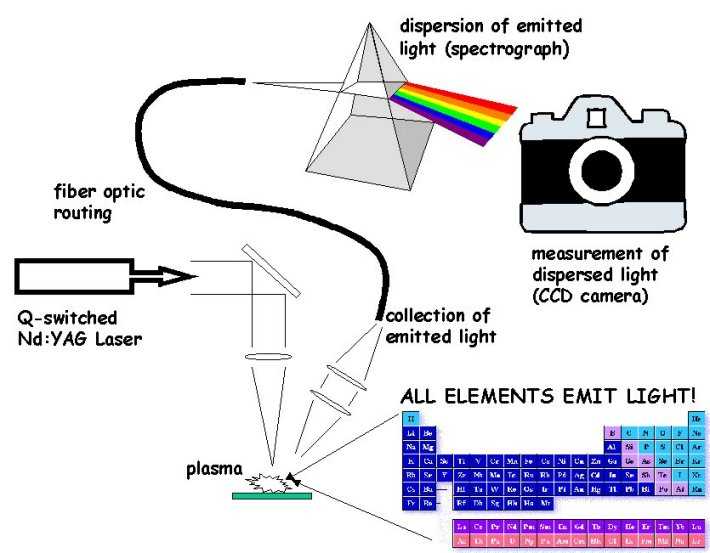|
ChemCam
Chemistry and Camera complex (ChemCam) is a suite of remote sensing instruments on Mars for the Curiosity (rover), ''Curiosity'' rover. As the name implies, ChemCam is actually two different instruments combined as one: a laser-induced breakdown spectroscopy (LIBS) and a Remote Micro Imager (RMI) telescope. The purpose of the LIBS instrument is to provide elemental compositions of rock and soil, while the RMI will give ChemCam scientists high-resolution images of the sampling areas of the rocks and soil that LIBS targets. The LIBS instrument can target a rock or soil sample from up to away, vaporizing a small amount of it with about 30 5-nanosecond pulses from a 1067 Nanometre, nm infrared laser and then observing the spectrum of the light emitted by the vaporized rock. Overview ChemCam has the ability to record up to 6,144 different wavelengths of ultraviolet, visible, and infrared light. Detection of the ball of luminous plasma is done in the visible, near-UV and near-infr ... [...More Info...] [...Related Items...] OR: [Wikipedia] [Google] [Baidu] |
Curiosity (rover)
''Curiosity'' is a car-sized Mars rover Space exploration, exploring Gale (crater), Gale crater and Mount Sharp on Mars as part of NASA's Mars Science Laboratory (MSL) mission. ''Curiosity'' was launched from Cape Canaveral Space Force Station, Cape Canaveral (CCAFS) on November 26, 2011, at 15:02:00 Coordinated Universal Time, UTC and landed on Aeolis Palus inside Gale crater on Mars on August 6, 2012, 05:17:57 UTC. The Bradbury Landing site was less than from the center of the rover's touchdown target after a journey. Mission #Goals and objectives, goals include an investigation of the Martian climate of Mars, climate and geology of Mars, geology, an assessment of whether the selected field site inside Gale has ever offered environmental science, environmental conditions favorable for Life on Mars, microbial life (including investigation of the Water on Mars, role of water), and planetary habitability studies in preparation for Human mission to Mars, human exploration. In ... [...More Info...] [...Related Items...] OR: [Wikipedia] [Google] [Baidu] |
Timeline Of Mars Science Laboratory
The Mars Science Laboratory and its rover, Curiosity rover, ''Curiosity'', were launched from Earth on 26 November 2011. As of , , ''Curiosity'' has been in Gale Crater on the Mars, planet Mars for Sol (day on Mars), sols ( days, total days; ') since landing on 6 August 2012. ''(See Timeline of Mars Science Laboratory#Current status, Current status.)'' Prelaunch (2004–2011) In April 2004, the United States National Aeronautics and Space Administration (NASA) called for scientific experiments and instruments proposals for the Mars Science Laboratory and rover mission. Launch was proposed for September 2009. By 14 December 2004, eight proposals were selected, including instruments from Russia and Spain. Testing of components also began in late 2004, including Aerojet's monopropellant engine with the ability to throttle from 15 to 100 percent thrust with a fixed propellant inlet pressure. By November 2008 most hardware and software development was complete, and testing cont ... [...More Info...] [...Related Items...] OR: [Wikipedia] [Google] [Baidu] |
N165
N165 ("Coronation" rock) is a Rock (geology), rock on the surface of Aeolis Palus in Gale (crater), Gale Crater on the planet Mars near the Bradbury Landing, landing site ("Bradbury Landing") of the Curiosity rover, ''Curiosity'' rover. The "approximate" site coordinates are: . On August 19, 2012, the rock was the first target of the rover's laser instrument, Chemistry and Camera complex, ChemCam, which can analyze targets at a distance using a laser and spectrometer. A Twitter feed for the rock was created, featuring an anthropomorphized account of its experiences. Its posts include a humor themed mix of social interaction and Mars content such as "''Did you know I was born in a volcano? Basalts like me come from lava. That's why we call it Olympus Mom''". The goal of this initial use of the laser on Mars was to serve as target practice for characterizing the instrument. The rock was primarily selected for its proximity to the rover, rather than any intrinsic scientific value. T ... [...More Info...] [...Related Items...] OR: [Wikipedia] [Google] [Baidu] |
Mars Science Laboratory
Mars Science Laboratory (MSL) is a robotic spacecraft, robotic space probe mission to Mars launched by NASA on November 26, 2011, which successfully landed ''Curiosity (rover), Curiosity'', a Mars rover, in Gale (crater), Gale Crater on August 6, 2012. The overall objectives include investigating Mars' Planetary habitability, habitability, studying its Climate of Mars, climate and Planetary geology, geology, and collecting data for a human mission to Mars. The rover carries a variety of scientific instruments designed by an international team. Overview MSL carried out the most accurate Martian landing of any spacecraft at the time, hitting a target landing ellipse of , in the Aeolis Palus region of Gale Crater. MSL landed east and north of the center of the target. This location is near the mountain Aeolis Mons (a.k.a. "Mount Sharp"). The Mars Science Laboratory mission is part of NASA's Mars Exploration Program, a long-term effort for the robotic exploration of Mars tha ... [...More Info...] [...Related Items...] OR: [Wikipedia] [Google] [Baidu] |
Composition Of Mars
The composition of Mars covers the branch of the geology of Mars that describes the make-up of the planet Mars. Elemental composition Mars is differentiated, which—for a terrestrial planet—implies that it has a central core made up of high density matter (mainly metallic iron and nickel) surrounded by a less dense, silicate mantle and crust. Like Earth, Mars appears to have a molten iron core, or at least a molten outer core. However, there does not appear to be convection in the mantle. Presently Mars shows little geological activity. The elemental composition of Mars is different from Earth's in several significant ways. First, Martian meteorite analysis suggests that the planet's mantle is about twice as rich in iron as the Earth's mantle. The planet's distinctive red color is due to iron oxides on its surface. Second, its core is richer in sulphur. Third, the Martian mantle is richer in potassium and phosphorus than Earth's and fourth, the Martian crust contains a ... [...More Info...] [...Related Items...] OR: [Wikipedia] [Google] [Baidu] |
SuperCam
SuperCam is a suite of remote-sensing instruments for the Mars 2020 '' Perseverance'' rover mission that performs remote analyses of rocks and soils with a camera, two lasers and four spectrometers to seek organic compounds that could hold biosignatures of past microbial life on Mars, if it ever existed there. SuperCam was developed in collaboration between the Research Institute in Astrophysics and Planetology () of the University of Toulouse in France, the French Space Agency (CNES), Los Alamos National Laboratory, the University of Valladolid (Spain), the University of Hawaii and the Universities of Basque Country and Málaga in Spain. The Principal Investigator is Roger Wiens from Los Alamos National Laboratory. SuperCam is an improved version of the successful ChemCam instruments of the ''Curiosity'' rover that have been upgraded with two different lasers and detectors. SuperCam is used in conjunction with the AEGIS (Autonomous Exploration for Gathering Increased Science) ta ... [...More Info...] [...Related Items...] OR: [Wikipedia] [Google] [Baidu] |
Martian Soil
Martian regolith is the fine blanket of unconsolidated, loose, heterogeneous superficial deposits covering the surface of Mars. The term ''Martian soil'' typically refers to the finer fraction of regolith. So far, no samples have been returned to Earth, the goal of a Mars sample-return mission, but the soil has been studied remotely with the use of Mars rovers and Mars orbiters. Its properties can differ significantly from those of terrestrial soil, including its toxicity due to the presence of perchlorates. Definitions On Earth, the term "soil" usually includes organic content. In contrast, planetary scientists adopt a functional definition of soil to distinguish it from rocks. ''Rocks'' generally refers to 10 cm scale and larger materials (e.g., fragments, breccia, and exposed outcrops) with high thermal inertia, with areal fractions consistent with the Viking Infrared Thermal Mapper (IRTM) data, and immobile under current aeolian (wind) conditions. Consequently, ''roc ... [...More Info...] [...Related Items...] OR: [Wikipedia] [Google] [Baidu] |
Gale (crater)
Gale is a crater, and probable dry lake, at in the northwestern part of the Aeolis quadrangle on Mars. It is in diameter and estimated to be about 3.5–3.8 billion years old. The crater was named after Walter Frederick Gale, an amateur astronomer from Sydney, Australia, who observed Mars in the late 19th century. Aeolis Mons, also known as Mount Sharp, is a mountain in the center of Gale and rises high. Aeolis Palus is the plain between the northern wall of Gale and the northern foothills of Aeolis Mons. Peace Vallis, a nearby outflow channel, 'flows' down from the hills to the Aeolis Palus below and seems to have been carved by flowing water. Several lines of evidence suggest that a lake existed inside Gale shortly after the formation of the crater. The NASA Mars rover ''Curiosity'', of the Mars Science Laboratory (MSL) mission, landed in "Yellowknife" ''Quad 51'' of Aeolis Palus in Gale at 05:32 UTC August 6, 2012. NASA named the landing location Bradbury Landi ... [...More Info...] [...Related Items...] OR: [Wikipedia] [Google] [Baidu] |
Exploration Of Mars
The planet Mars has been explored remotely by spacecraft. Uncrewed spacecraft, Probes sent from Earth, beginning in the late 20th century, have yielded a large increase in knowledge about the Martian system, focused primarily on understanding Geology of Mars, its geology and Planetary habitability, habitability potential. Engineering Interplanetary spaceflight, interplanetary journeys is complicated and the exploration of Mars has experienced a high failure rate, especially the early attempts. Roughly sixty percent of all spacecraft destined for Mars failed before completing their missions, with some failing before their observations could begin. Some missions have been met with unexpected success, such as the twin Mars Exploration Rovers, ''Spirit (rover), Spirit'' and ''Opportunity (rover), Opportunity'', which operated for years beyond their specification. Current status There are two functional rovers on the surface of Mars, the Curiosity (rover), ''Curiosity'' and Persever ... [...More Info...] [...Related Items...] OR: [Wikipedia] [Google] [Baidu] |
Laser-induced Breakdown Spectroscopy
Laser-induced breakdown spectroscopy (LIBS) is a type of atomic emission spectroscopy which uses a highly energetic laser pulse as the excitation source. The laser is focused to form a plasma, which atomizes and excites samples. The formation of the plasma only begins when the focused laser achieves a certain threshold for optical breakdown, which generally depends on the environment and the target material. 2000s developments From 2000 to 2010, the United States Army Research Laboratory, U.S. Army Research Laboratory (ARL) researched potential extensions to LIBS technology, which focused on hazardous material detection. Applications investigated at ARL included the standoff detection of explosive residues and other hazardous materials, plastic landmine discrimination, and material characterization of various metal alloys and polymers. Results presented by ARL suggest that LIBS may be able to discriminate between energetic and non-energetic materials. Research Broadband hig ... [...More Info...] [...Related Items...] OR: [Wikipedia] [Google] [Baidu] |
Chemical Elements
A chemical element is a chemical substance whose atoms all have the same number of protons. The number of protons is called the atomic number of that element. For example, oxygen has an atomic number of 8: each oxygen atom has 8 protons in its nucleus. Atoms of the same element can have different numbers of neutrons in their nuclei, known as isotopes of the element. Two or more atoms can combine to form molecules. Some elements form molecules of atoms of said element only: e.g. atoms of hydrogen (H) form diatomic molecules (H). Chemical compounds are substances made of atoms of different elements; they can have molecular or non-molecular structure. Mixtures are materials containing different chemical substances; that means (in case of molecular substances) that they contain different types of molecules. Atoms of one element can be transformed into atoms of a different element in nuclear reactions, which change an atom's atomic number. Historically, the term "chemical ele ... [...More Info...] [...Related Items...] OR: [Wikipedia] [Google] [Baidu] |









